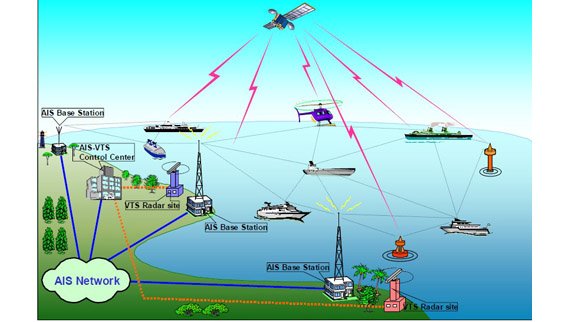- L’AIS = Automatic Identification System, and also Anti-Collision
As its name suggests, AIS allows for the unique identification of a ship and plays an important role in ship safety by helping to avoid collisions, provided the terminal is not disactivated (so as to preserve one’s fishing zone, for example).
AIS is, by far, the most complete and complex system of those mentioned above. This is not the right place to go into technical details but to sketch principal functions and possible future developments.
AIS’s prime task is to improve the safety of shipping:
![]() by authorising a ship-to-ship connexion so as to avoid collision
by authorising a ship-to-ship connexion so as to avoid collision
![]() as a means for coastal states to obtain information on ships and their cargoes
as a means for coastal states to obtain information on ships and their cargoes
![]() as a ship-to-shore Vessel Traffic System tool for the management of maritime traffic.
as a ship-to-shore Vessel Traffic System tool for the management of maritime traffic.
AIS is often coupled to a coastal radar to complete information passed to the coastal state.
AIS GENERALITIES
Free information service : www.marinetraffic.com
Paying information service : http://www.lloydslistintelligence.com/llint/ais.htm
((Largest word AIS database with 61 million positions displayed per day sent by position 72000 ships from 132 different countries))
About 70% of AIS data is supplied by terrestrial stations and about 30% by AIS satellites.
SATELLITE AIS
Two main operators share the market today:
 |
 |
THE PRESENT-DAY AIS HAS 2 FLAWS :
1. It is the victim of its own success with signs of saturation on certain oceans with very high ship density per km², such as the North Sea or the Sea of China (greater than 1), or high (0.2) as in the Mediterranean and the Black Sea.
2. Absence of confidentiality in data exchange.
To overcome this progressive saturation and lack of confidentiality, the world AIS system is condemned to change.
Change will come about through :
![]() VDL (VHF Digital link) Thanks to digital transmission, you only need to detect part of the message sent by a distant ship to update its position regularly.
VDL (VHF Digital link) Thanks to digital transmission, you only need to detect part of the message sent by a distant ship to update its position regularly.
![]() Technological evolution combining classical radio-localisation based on TDoA (Time Difference on Arrival) and an Extended Kalman Filter (EKF).
Technological evolution combining classical radio-localisation based on TDoA (Time Difference on Arrival) and an Extended Kalman Filter (EKF).
(…I know it looks simple at first or second sight... We shall attempt to clarify concepts at a later date…)
![]() International regulation changes and changes in frequency spectrums
International regulation changes and changes in frequency spectrums



